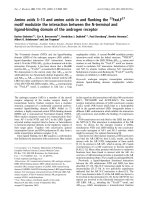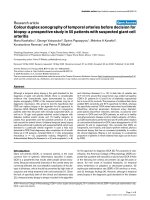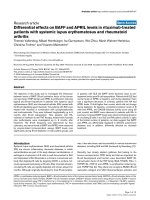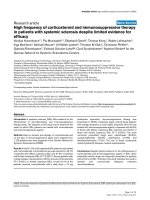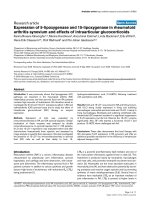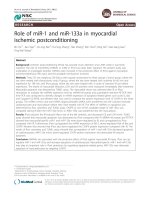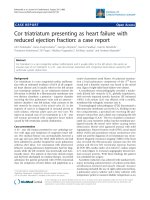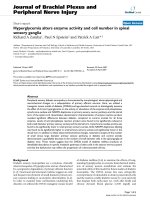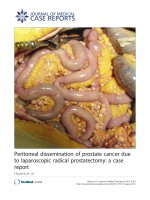Báo cáo y học: " Breast size, bra fit and thoracic pain in young women: a correlational study" pptx
Bạn đang xem bản rút gọn của tài liệu. Xem và tải ngay bản đầy đủ của tài liệu tại đây (268.63 KB, 7 trang )
BioMed Central
Page 1 of 7
(page number not for citation purposes)
Chiropractic & Osteopathy
Open Access
Research
Breast size, bra fit and thoracic pain in young women: a
correlational study
Katherine Wood
1
, Melainie Cameron*
2,3
and Kylie Fitzgerald
1
Address:
1
School of Health Science, Victoria University, Melbourne, Australia,
2
School of Human Movement, Recreation and Performance, Victoria
University, Melbourne, Australia and
3
Centre for Ageing, Rehabilitation, Exercise and Sport, Victoria University, Melbourne, Australia
Email: Katherine Wood - ; Melainie Cameron* - ;
Kylie Fitzgerald -
* Corresponding author
Abstract
Introduction: A single sample study was undertaken to determine the strength and direction of
correlations between: a) breast size and thoracic spine or posterior chest wall pain; b) bra fit and
thoracic spine or posterior chest wall pain and; c) breast size and bra fit, in thirty nulliparous
women (18–26 years), with thoracic spine or posterior chest wall pain, who wore bras during
daytime.
Measures: Pain (Short Form McGill Pain Questionnaire), bra size (Triumph International), bra fit
(Triumph International).
Results: Most (80%) women wore incorrectly sized bras: 70% wore bras that were too small, 10%
wore bras that were too large. Breast size was negatively correlated with both bra size (r = -0.78)
and bra fit (r = -0.50). These results together indicate that large breasted women were particularly
likely to be wearing incorrectly sized and fitted bras. Negligible relationships were found between
pain and bra fit, and breast size and pain. Menstrual cycle stage was moderately positively correlated
with bra fit (r = 0.32).
Conclusion: In young, nulliparous women, thoracic pain appears unrelated to breast size. Bra fit
is moderately related to stage of menstrual cycle suggesting that this research may be somewhat
confounded by hormonal changes or reproductive stage. Further research is needed to clarify
whether there is a relationship between breast size or bra fit and thoracic pain in women during
times of hormonal change.
Introduction
Back pain, including thoracic spinal pain, is a common,
potentially disabling, routine presenting complaint to
general practitioners [1]. Macromastia is the state of hav-
ing disproportionately large breasts. Some macromastic
women report breast pain and other symptoms, and the
intuitively logical assumption is that breast size is the key
influence on clinical presentation [2]. Clinical symptoms
attributed to macromastia include neck, thoracic spine
and shoulder pain, breast pain, headaches, grooving and
associated pain caused by bra straps, intertrigo (inflam-
mation of skinfolds), and ulnar nerve paresthesia [3].
Breast size and mass changes across the life-span [4,5] sug-
gesting that macromastic symptoms may occur episodi-
cally during particular stages of life. Although these
Published: 13 March 2008
Chiropractic & Osteopathy 2008, 16:1 doi:10.1186/1746-1340-16-1
Received: 7 July 2007
Accepted: 13 March 2008
This article is available from: />© 2008 Wood et al; licensee BioMed Central Ltd.
This is an Open Access article distributed under the terms of the Creative Commons Attribution License ( />),
which permits unrestricted use, distribution, and reproduction in any medium, provided the original work is properly cited.
Chiropractic & Osteopathy 2008, 16:1 />Page 2 of 7
(page number not for citation purposes)
symptoms are widely reported, the relationship between
breast size and symptoms is somewhat unclear. Breast
mass and breast density appear to be important variables.
Most outcome studies of reduction mammaplasties sup-
port the view that larger breasts equate to greater health
burden [6-12] and demonstrate this relationship through
symptom improvement post-surgery, but a recent review
of 59 women who underwent reductions involving the
removal of less than 1000 g of breast tissue showed that
small reductions in breast mass may result in statistically
significant improvements in macromastic symptoms [2].
Breast-related thoracic spinal pain is thought to result
from changes in centre of gravity [12]. Findikcioglu and
colleagues demonstrated that static spinal posture differs
significantly according to breast size [13]. Letterman and
Scheuter [12] argued that large breasts can increase cervi-
cal lordosis and thoracic kyphosis, shift the centre of grav-
ity away from the spine and increase muscular effort
required to maintain balance. They also suggested that
large or heavy breasts may also lead to continuous tension
on the middle and lower fibres of the trapezius muscle
and associated muscle groups [12].
Greenbaum, Heslop and Morris [11] estimated that 70%
of women wear bras that are incorrect sizes or poorly fit-
ted. Ryan [14] proposed that elevation of the breasts in a
bra increased downward forces on the outer scapula. He
suggested that the posterior straps of a bra act as pulleys
over the shoulders, effectively doubling the total down-
ward pull on both shoulders. Associated neck, shoulder
and back pain could then, at least partially, be attributed
to fatigue in muscles that reverse scapular depression (eg:
trapezius, serratus anterior). Bra-strap pressure is only
somewhat linked to bust mass: small busted women with
tight straps may experience considerable downward pres-
sure on their shoulders [11,14].
Breast size and mass vary throughout life, influenced by
hormonal changes, body fat composition, stage of repro-
ductive cycle, and breast pathology [4,5]. Bra size, when
fitted according to defined industry standards [15], may
be used as an estimate of breast size. Across the lifespan
and across the population, bra size is not a consistent
measure of breast mass which is most accurately esti-
mated from radiographic measures of volumetric density
[16], but among healthy women who have never been
pregnant or experienced breast pathology, bra size is likely
to be a consistent measure [13]. In this study we examined
the correlations between actual bra size (as an estimate of
breast size), bra fit, and point-in-time reporting of tho-
racic pain in a group of nulliparous young adult women
in order to begin exploring the questions: Do larger
breasted women experience more thoracic pain than
small breasted women? Could an incorrectly fitted or
sized bra contribute to women's thoracic pain? Clarifica-
tion of these relationships may aid in the care of women
presenting with thoracic pain.
Method
This study was approved by the Victoria University
Human Research Ethics Committee. All participants pro-
vided written informed consent for their participation in
the study.
Participants
Thirty women (18–26 years) with self-reported posterior
thoracic pain, who wore bras during daytime hours, vol-
unteered to participate in the study. Posterior thoracic
pain was defined as pain felt anywhere in the posterior
aspect of the thoracic cage, in the region bordered by first
ribs and first thoracic vertebra superiorly and the twelfth
vertebra and ribs inferiorly, and including the periscapu-
lar areas.
Recruitment posters for this study, displayed at Victoria
University (City Flinders campus), invited women aged
between 18 and 50 years, who regularly wore bras (not
strapless) during the daytime but not during nighttime
sleeping, and were currently experiencing non-specific
"upper back pain" to volunteer for this study. Volunteers
were excluded if at the time of the study, or in the three
months prior or one month following, they: (a) were able
to report specific pathology that explained their posterior
thoracic pain, (b) were pregnant, breast-feeding, or
expressing breast milk, (c) were menopausal or experienc-
ing symptoms possibly attributable to menopause, (d)
reported breast changes related to commencing or ceasing
use of an oral contraceptive pill, or (e) reported body
weight gain or loss of more than 5 kg.
Measures
Data collection for this study comprised 4 steps. Partici-
pants completed a screening survey to ensure inclusion
criteria were met and to estimate menstrual cycle stage
(see Additional file 1), and a self-report measure of pain
nature and intensity (short-form McGill Pain Question-
naire [17]). Current bra fit was assessed using observation
criteria for bra fit (Triumph International; see Additional
file 2). Actual bra size, as an estimate of breast size, was
assessed by band and cup size measurements using estab-
lished international guidelines [15].
Menstrual cycle stage: The typical 28 day menstrual cycle
was divided into 4 stages of approximately one week each.
Numerical labels from 1 to 4 were attributed to menstrual
cycle stages (1 = pre-menstrual, 2 = menstruating, 3 =
post-menstrual, 4 = mid-cycle). Participants were asked to
self-report their menstrual cycle stage by recalling the date
Chiropractic & Osteopathy 2008, 16:1 />Page 3 of 7
(page number not for citation purposes)
of their most recent menstruation and counting forward
in weeks.
Short-form McGill Pain Questionnaire [17]: Three numer-
ical scores of pain were derived from sub-scales (total
pain, sensory pain, affective pain) of the short-form
McGill Pain Questionnaire. Two further sub-scales, the
present pain index (PPI) and a visual analogue scale
(VAS), returned categorical (range 0–5, 0 = no pain, 5 =
excruciating) and numerical measures (range 0–100, 0 =
no pain, 100 = worst possible pain) of the severity of cur-
rent pain.
Bra Fit
Categories of bra fit were allocated numerical scores in the
range -4 to 4, with 0 indicating a correctly fitted bra. 4
observational criteria, each scored +1 if present, were used
to determine if a bra was too large, and another 4 criteria,
each scored -1 if present, were used to determine if a bra
was too small. The overall score of bra fit was the sum of
scores for each criterion. A negative score indicated that
the current bra worn was too small and a positive score
indicated that the current bra was too large. The numerical
part of score indicated the net number of criteria on which
a bra was identified as poorly fitted.
Bra size
Bra size measures yielded two numerical scores: a) actual
bra size [15], which was assumed to be an estimate meas-
ure of breast size, and b) difference between bra size worn
and that measured as actual bra size (bra size difference).
Bra size was a two part measure comprising cup size and
band size (see Figure 1). Cup size is thoracic circumfer-
ence across the fullest part of the breasts, converted to cat-
egorical classification ranging from AA (smallest) to F
(largest in this study). Band size is thoracic circumference
under the bust at the level of the inframammary fold, con-
verted to categorical classification ranging from 10 to 22,
approximately equal to dress size [13]. Bra size difference
score was also a two part score, comprising a sign that
indicated whether the bra worn was too small (negative)
or too large (positive), and a numerical score that indi-
cated the number of bra size categories between the bra
worn and the bra fitted.
Data Analysis and Conventions for Interpretation
Pearson's correlation co-efficients (r) were calculated to
determine the strength and direction of linear relation-
ships between pairs of numerical variables. Effect sizes
were calculated as r
2
. Consistent with Cohen's conven-
tions, correlations were interpreted according to size as
well as direction [18]. Correlations of less than 0.3 are
described as small or weak, between 0.3 and 0.5 are
medium or moderate, and greater than 0.5 are large or
strong [18,19].
Results
Thirty young women (18–26 years) participated in this
study, and 26 women provided complete data sets. Sum-
mary data for each participant are provided in Table 1.
Missing data
Four women did not respond to the survey item regarding
current stage of their menstrual cycle, and one participant
reported amenorrhea, so these participants' data were
excluded from some analyses. Two women omitted the
VAS and PPI of the McGill pain questionnaire. Four
women returned zero scores (no pain) on the VAS and
seven women returned zero scores (no pain) on the PPI,
but each of these women reported some current pain on
the word lists of the McGill pain questionnaire. Because of
these discrepancies in the data set, the VAS and PPI sub-
scales were excluded from the analyses.
Bra fit scores revealed that the majority (80%) of partici-
pants were wearing bras that were was the wrong size for
Bra size measurementsFigure 1
Bra size measurements.
Chiropractic & Osteopathy 2008, 16:1 />Page 4 of 7
(page number not for citation purposes)
them, with 70% wearing bras that were too small and
10% wearing bras that were too large (see Figure 2). Bra
size difference scores ranged from 1 to -3, with a clustering
of scores at the negative end of this range, indicating that
most women self-selected bras that were too small (see
Table 1).
A large negative correlation (r = -0.78) was identified
between actual bra size (breast size) and bra size differ-
ence. These results indicate that there was a strong linear
relationship between the size of women's breasts and the
size of bras they selected for themselves. It appears that
women do not simply choose bras in the wrong size. More
specifically, the larger a woman's breasts, the more likely
she will be wearing bras that were too small, and con-
versely, the smaller a woman's breasts, the more likely she
will choose bras that were too big.
Bra size difference and bra fit were strongly positively cor-
related (r = 0.55). This relationship was unsurprising,
indicating that the worse a bra fitted the more likely that
bra was the wrong size for the woman wearing it. A mod-
erate negative correlation was also found between breast
size and bra fit (r = -0.50), suggesting that larger breasted
women were more likely to be wearing ill fitting bras.
A small negative correlation was seen between breast size
and total pain (r = -0.23). Negligible correlations were
identified between bra fit and self-reported scores of both
total pain (r = 0.036) and sensory pain (r = 0.032).
Moderate correlations were found between menstrual
cycle stage and both bra fit (r = 0.32) and bra size differ-
ence (r = 0.29).
Discussion
That 80% of participants were wearing incorrectly sized
bras is consistent with previous studies [11,20]. Bra-sizing
and fitting are learned skills and may be difficult to per-
form on oneself. Most women are not trained in bra-siz-
ing, but make bra purchasing decisions unassisted.
Annual professional bra-sizings are recommended, but
many women do not seek these [11], possibly because
bra-sizing services are typically undertaken by bra sales-
Table 1: Summary of data set for each participant
Participant Age Pain
duration
Bra
fitted
Bra Size
(score)
Bra Fit
(score)
Bra size
worn
Bra Size
Difference
Menstrual
Stage
Total
Pain
Sensory
Pain
Affective
Pain
1 18 5 12A 4 0 10A -1 post 16 12 4
2 18 4 10B 4 2 10B 0 pre 3 3 0
3 18 3 10B 4 -1 10C 1 men 15 11 4
4 26 4 12D 7 -1 12C -1 men 6 5 1
5 18 6 10D 6 0 10D 0 - 4 3 1
6 18 6 10C 5 -1 10B -1 pre 6 5 1
7 18 6 16DD 10 -3 14C -3 mid 10 8 2
8 18 6 12DD 8 -1 12D -1 post 5 4 1
9 18 6 10C 5 1 10B -1 pre 6 5 1
10 18 6 12D 7 -2 12C -1 mid 5 5 0
11 18 6 10C 5 -1 12B 0 post 5 5 0
12 18 6 14E 10 -1 12DD -2 post 1 1 0
13 18 6 14F 11 -1 14D -3 mid 7 7 0
14 18 6 10D 6 -2 10C -1 pre 15 11 4
15 18 6 10E 8 -3 10D -2 pre 2 2 0
16 18 6 12AA 3 1 12B 2 mid 7 6 1
17 18 5 12DD 8 -2 12D -1 mid 7 5 2
18 18 5 12DD 8 1 14B -2 - 10 9 1
19 18 5 10D 6 0 10B -2 post 11 11 0
20 18 6 12D 7 -1 12C -1 mid 9 8 1
21 18 2 10C 5 0 12B 0 pre 4 4 0
22 18 6 12B 5 0 10B -1 - 5 5 0
23 18 3 10B 4 2 12B 1 - 5 5 0
24 19 4 12D 7 -3 12B -2 post 9 7 2
25 18 6 10A 3 -1 10AA -1 am 12 12 0
26 18 5 10D 6 -1 10C -1 men 5 5 0
27 18 6 10D 6 -3 10C -1 men 6 4 2
28 18 3 12DD 8 -3 12C -2 mid 5 5 0
29 18 5 12A 4 0 12A 0 pre 7 7 0
30 18 6 14B 6 2 10D 0 pre 13 7 6
Pain duration: Categorical scores 1 to 6 indicate self-reported duration of pain. 1 = <2 week, 2 = <1 month, 3 = <3 months, 4 = <6 months, 5 = 6–
12 months, 6 = >1 year
Menstrual stage: Categorical labels indicate self-reported stage of menstrual cycle. Pre = week before menstrual period, men = currently
menstruating, post = week following menstrual period, mid = mid-cycle, approximately 2 weeks following last menstrual period, am = amenorrhea,
no regular menstrual cycle.
Chiropractic & Osteopathy 2008, 16:1 />Page 5 of 7
(page number not for citation purposes)
people, leaving women feeling somewhat compelled to
purchase bras from the people conducting the sizings.
Also, women, particularly larger busted women, may
experience feelings of embarrassment and self-conscious-
ness during bra sizings, tempting women to avoid such
appointments and attempt to size and fit their own bras.
Interpreting the large negative correlation between breast
size and bra size in conjunction with the moderate nega-
tive correlation between breast size and bra fit and our
participants' tendency to self-select bras that are too small,
we suggest that women with large breasts are more likely
than their small breasted counterparts to be wearing
incorrectly sized and fitted bras. There are several possibly
explanations for why being large breasted is particularly
associated with wearing a bra that is poorly fitted or the
wrong size. Measurement of the underband and overbust
is a reasonably accurate for cup sizes ranging between AA
and C, but declines somewhat for the larger cup sizes (D
through to F) [20]. Put simply, it is easier to accurately size
bras for smaller breasted women. Larger breasted women
are more prone to incorrect bra sizing because their
breasts may be ptotic and bulbous, making accurate over-
bust measurement difficult. When taking the underband
measurement there is a tendency to cut into excess flesh
with the tape measure magnifying the inaccuracy of cup-
size measurement [11]. Accurate bra fit is similarly diffi-
cult for overweight and obese women [13]. When discuss-
ing this study at a conference, a "well-endowed" colleague
suggested that we plan a follow up study recruiting
women with breast sizes DD and larger in order to further
explore these relationships among larger breasted women
in particular.
That the negative correlation between breast size and bra
fit was only moderate, rather than large like the correla-
tion between breast size and bra size, suggests that women
may be able to somewhat compensate for selecting incor-
rect bra sizes through the fitting adjustments built into
most bras. In the underwear industry, there is some
understanding of bra size equivalence; for example, a 10C
bra can be adjusted to fit a 12B woman by shortening the
shoulder straps and lengthening the underbust band [15].
We have taken this equivalence into consideration when
assessing bra fit, and this overlap in fit between sizes also
contributes to explaining why these two negative correla-
tions are not of approximately equal magnitude.
Although bra fit appears unrelated to pain, if a bra is
poorly fitted, bra function (eg: breast support, reduction
of breast bounce) may be compromised. Bras are poten-
tially expensive, rarely seen, underwear items. It is likely
that many women do not replace their bras regularly. Like
all items of clothing, the shape and structure of bras may
deteriorate with age, use, and laundering, and a bra that
fitted well at the time of purchase, might not fit so well
months or years later.
In this study, small breast size correlated somewhat with
greater severity of self-reported pain. Although this corre-
lation was small, it appears to contradict the results of
most studies of reduction mammaplasty in which partici-
pants reported either complete or partial reduction in tho-
racic pain following surgical reduction of breast mass
[3,6-10,21,22]. The effect size corresponding to a correla-
tion of -0.23 is r
2
= 0.04, indicating that only 4% of the
variance is pain scores is accounted for by breast size.
Using the McGill Pain Questionnaires (including short-
form) participants are required to report pain severity
according to various descriptors of pain (eg: burning, nag-
ging, crushing). Because these instruments probe an indi-
vidual's perception of pain, they may not be ideal
instruments for comparing pain severity between individ-
uals. Pain is a personal phenomenon, and 4% variance in
pain across a group may be associated, genuinely or oth-
erwise, with almost anything [17].
Our results do not explain pain as a correlate of breast
size. Note that most of the current evidence that large
breasts explain pain is based on post-surgical data [3,6-
10,21,22] and recent case review suggests that reduction
in breast mass might not be the variable of primary
importance [2]. In 1993 Gonzalez et al [4] re-defined
macromastia, removing specific reference to breast size
and emphasizing clinical symptoms and functioning. We
concur with Gonzalez et al's view that symptoms and
function are likely to be more important than breast size
per se. Although we acknowledge that women may have
multiple reasons for seeking breast reduction surgery, we
suggest that pain is likely to be a primary motivator, and
that the sample of women volunteering for post-surgical
Categorical Classification of Bra FitFigure 2
Categorical Classification of Bra Fit.
Too large
10%
Too small
70%
Correct size
20%
Chiropractic & Osteopathy 2008, 16:1 />Page 6 of 7
(page number not for citation purposes)
studies might not be representative of macromastic
women.
Participants in our study were young women students,
and none had ever been pregnant. Other possible corre-
lates of thoracic spinal pain, such as prolonged study pos-
tures and emotional stress, need to be considered in these
participants. In young non-pregnant women, thoracic
pain is probably multifactorial rather than directly related
to breast size or bra fit. Participants in previous studies
linking breast size to thoracic pain were aged from 32 to
40.6 years [3,6-10,21,22] and some participants had born
and breast fed children. Breast morphology is likely to dif-
fer between these groups.
Female breasts are affected by hormonal changes associ-
ated with menstruation, pregnancy, menopause, and
some pathology [4,5]. Monthly fluctuations of estrogen
and progesterone are believed responsible for the com-
mon changes, including increased breast size and tender-
ness that many women experience in the week preceding
their period [23]. In our sample, menstrual cycle stage cor-
related moderately with both bra fit and bra size differ-
ence, suggesting that women may require bras of a
different fit or size at different stages of their menstrual
cycles. These results have implications for future research
and also for the underwear industry [24]. We recommend
that stage of menstrual cycle be accounted for as a con-
founding factor in future research designs.
In designing this study, it was not possible to account for
all possible correlates of thoracic pain among our young
women. We acknowledge that participants' occupations,
sporting activities, and other daily habits may have con-
founded our results. Also, we did not take any anthropo-
metric measures in this study, nor correlate such variables
with breast size, bra fit, or back pain. We acknowledge
that body mass, and in particular, percentage body fat,
may influence breast size and possibly breast mass
[4,5,13,20]. We reiterate that the purpose of this study was
to explore the relationship between bra fit, breast size, and
thoracic pain. If a strong and consistent relationship
between breast size and thoracic pain were identified,
then future research and clinical interventions might rea-
sonably be directed towards investigation of variables
possibly correlated with breast size.
Small sample size and limited age range compromises the
generalisability of this research. Follow-up studies are
needed to establish a more comprehensive information
base and we recommend that these studies include more
women across the range of adulthood, from various occu-
pational groups, and with diverse levels of current and
past physical activity engagement. We recommend that
future research in this area further explores correlates of
macromastia and thoracic spinal pain, and investigates
alternative treatment methods to reduction mammaplasty
for relieving macromastic pain.
Conclusion
This point in time snapshot of young adult women stu-
dents reporting thoracic spinal pain suggests that there is
little meaningful correlation between breast size and pain
intensity, or between pain and bra fit. Breast size corre-
lated strongly and negatively with bra size, and moder-
ately with bra fit, but was not highly correlated with pain
severity.
Competing interests
The author(s) declare that they have no competing inter-
ests.
Authors' contributions
This study was completed by KW in partial fulfillment of
a Masters degree. MC and KF acted as supervisors. KW
conceived the idea for the study. KW and MC designed the
study and sought ethical approval. KW collected the data.
KW and MC analysed the data. KF assisted in supervision
when MC moved to another department partway through
the study. All authors contributed to writing this manu-
script, and reviewed and edited this manuscript for publi-
cation.
Additional material
Acknowledgements
Triumph International kindly provided comprehensive bra fitting training
for Katherine Wood.
References
1. Australian Bureau of Statistics: Musculoskeletal Conditions in
Australia: A Snapshot. Canberra: ABS ABS publication
4823.0.55.001; 2003.
2. Spector JA, Karp NS: Reduction mammaplasty: A significant
improvement at any size. Plast Reconstr Surg 2007, 120:845-850.
Additional file 1
Screening survey. Screening survey administered to collect demographic
data and ensure that all participants satisfied inclusion criteria.
Click here for file
[ />1340-16-1-S1.doc]
Additional file 2
Observational criteria for bra fit. Checklist used to determine whether the
bra worn was too large or too small, and to what extent the fit differed
from Triumph International guidelines.
Click here for file
[ />1340-16-1-S2.doc]
Publish with BioMed Central and every
scientist can read your work free of charge
"BioMed Central will be the most significant development for
disseminating the results of biomedical research in our lifetime."
Sir Paul Nurse, Cancer Research UK
Your research papers will be:
available free of charge to the entire biomedical community
peer reviewed and published immediately upon acceptance
cited in PubMed and archived on PubMed Central
yours — you keep the copyright
Submit your manuscript here:
/>BioMedcentral
Chiropractic & Osteopathy 2008, 16:1 />Page 7 of 7
(page number not for citation purposes)
3. Schnur PL, Schnur DP, Petty PM, Hanson TJ, Weaver AL: Reduction
Mammaplasty: An Outcome Study. Plast Reconstr Surg 1996,
100(4):875-883.
4. Butler LM, Gold EB, Greendale GA, Crandall CJ, Modugno F, Oestre-
icher N, Quesenberry CP Jr, Habel LA: Menstrual and reproduc-
tive factors in relation to mammographic density: The Study
of Women's Health Across the Nation (SWAN). Breast Cancer
Res Treat in press. 2007, Dec 9
5. Scheurnhammer ES, Tworoger SS, Eliassen AH, Missmer SA, Holly JM,
Pollak MN, Hankinson SE: Body shape throughout life and cor-
relations with IGFs and GH. Endocr Relat Cancer 2007,
14:721-732.
6. Gonzalez F, Walton RL, Shafer B, Matory WE Jr, Borah GL: Reduc-
tion mammaplasty improves symptoms of macromastia.
Plast Reconstr Surg 1993, 91:1270-1276.
7. Brühlmann Y, Tschopp H: Breast reduction improves symptoms
of macromastica and has long-lasting effect. Ann Plastic Surg
1998, 41(3):240-245.
8. Raispis T, Zehring D, Downey DL: Long-term functional results
after reduction mammaplasty. Ann Plastic Surg 1995,
34(2):113-116.
9. Glatt BS, Sarwer DB, O'Hara DE, Hamori C, Bucky LP, LaRossa D: A
retrospective study of changes in physical symptoms and
body image after reduction mammaplasty. Plast Reconstr Surg
1999, 103:76-82.
10. Netscher DT, Meade RA, Goodman CM, Brehm BJ, Friedman JD,
Thornby J: Physical and psychological symptoms among 88
volunteer subjects compared with patients seeking plastic
surgery procedures to the breast. Plast Reconstr Surg 2000,
105:2366-2373.
11. Greenbaum AR, Heslop T, Morris J: An investigation of the suit-
ability of bra fit in women referred for reduction mamma-
plasty. Brit J Plast Surg 2004, 56(3):230-236.
12. Letterman G, Schurter M: The effects of mammary hypertrophy
of the skeletal system. Ann Plast Surg 1980, 5:425-431.
13. Findikcioglu K, Findikcioglu F, Ozmen S, Guclu T: The impact of
breast size on the vertebral column: A radiologic study. Aes-
thetic Plast Surg 2007, 31:23-27.
14. Ryan EL: Breast weight and industrial fatigue. Med J Aust 1984,
147(5):261.
15. Triumph International: Brastylist: Books of bras. Triumph Interna-
tional Australia 2005.
16. Jeffreys M, Warren R, Highnam R, Davey Smith G: Breast cancer
risk factors and a novel measure of volumetric breast den-
sity: A cross-sectional study. Br J Cancer 2008, 98:210-216.
17. Melzack R: The short-form McGill Pain Questionnaire. Pain
1987, 30:191-197.
18. Cohen J: Statistical power analysis for the behavioral sciences.
Hillsdale, NJ: Erlbaum; 1988.
19. Cohen J: Things I have learned (so far). American Psychologist
1990, 45:1304-1312.
20. Pechter E: Bra cup size depends on band size. Plast Reconstr Surg
1999, 104:300-301.
21. Mizgala CL, MacKenzie KM: Breast reduction outcome study.
Ann Plast Surg 2000, 44:125-134.
22. Boschert MT, Barone CM, Puckett CL: Outcome analysis of
reduction mammaplasty. Plast Reconstr Surg 1996, 98:451-454.
23. Oregon Health and Science University: Breast Health c2001–
2006. [ />normal_breast_development.cfm]. Accessed 28/10/2006
24. Page KA, Steele JR: Breast motion and sports brassiere design:
Implications for further research. Sports Medicine 1999,
27:205-211.
